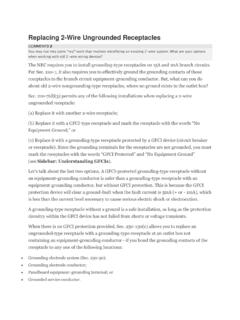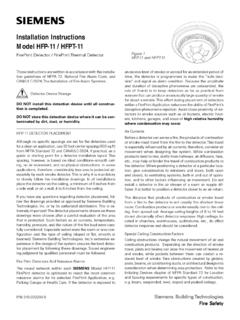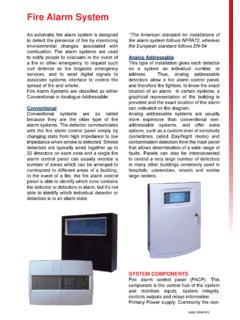Transcription of The purpose of this article by Gordon Fox of Fox ...
1 The purpose of this article by Gordon Fox of Fox Inspection Group (713) 723-3330 is to explain the current law(s) requiring the presence of Carbon Monoxide and smoke detectors to be in place for any / all residential properties sold today. Cliff notes: for those who only need the summary and don t have time for the details Required to have a Carbon Monoxide detector in any home sold that has any fuel burning appliances, (gas heater, gas cook top, fireplace, etc.) ALL electric homes are apparently exempt. Required to have smoke alarms in any home sold, locations include every bedroom, in the bedroom hall in the immediate vicinity of doors to the bedroom and every floor if more than 1 story in height.
2 Don t worry about the technical details of physical locations of sensors, activation of 1 alarm needs to set off all the others, must be audible through out house, if hearing impaired must have visual indicator, alarms older than 10 years need to be replaced due to loss of sensitivity, and other silly requirements as all that additional technical fluff is just to help save a few more lives. However if you insist on knowing more, read CO and smoke alarm law in Texas effective Jan. 1, 2008 Ref: SB 338 and The Health and The Human Services Commission Section , Health and Safety Code It appears lawmakers this spring approved a bill sponsored by Pickett and State Senator Leticia Van de Putte, which requires smoke detectors in all new homes and all homes sold in Texas starting in 2008.
3 Governor Rick Perry signed the bill. (effective Sept. 1, 2007) A BILL TO BE ENTITLED AN ACT relating to carbon monoxide alarms and smoke detectors in certain residential dwellings. BE IT ENACTED BY THE LEGISLATURE OF THE STATE OF TEXAS: SECTION 1. Subtitle A, Title 9, Health and Safety Code, is amended by adding Chapter 766 to read as follows: CHAPTER 766. CARBON MONOXIDE ALARMS AND smoke detectors IN CERTAIN RESIDENTIAL DWELLINGS Sec. DEFINITIONS. In this chapter: (1) "Carbon monoxide alarm" means a device that detects and sounds an alarm to indicate the presence of a harmful level of carbon monoxide gas.
4 (2) "Commission" means the Health and Human Services Commission. (3) "Fossil fuel" includes coal, kerosene, oil, wood, fuel gases, and other petroleum or hydrocarbon products. (4) "One-family or two-family dwelling" means a structure that has one or two residential units that are occupied as, or designed or intended for occupancy as, a residence by individuals. (5) " smoke detector" has the meaning assigned by Section Sec. CARBON MONOXIDE ALARM REQUIRED. (a) Each one-family or two-family dwelling that has a household appliance or heating system that burns a fossil fuel must have a working carbon monoxide alarm installed in the dwelling in accordance with commission rules if construction on the dwelling commences on or after January 1, 2008.
5 (b) Each one-family or two-family dwelling that has a household appliance or heating system that burns a fossil fuel that is constructed before January 1, 2008,must have a working carbon monoxide alarm installed in the dwelling in accordance with commission rules before the owner of the dwelling may sell or otherwise transfer ownership of the dwelling to another person. (c) The carbon monoxide alarm must: (1) comply with Underwriters Laboratories, Inc., Standard 2034 or Canadian Standards Association Standard ; and (2) be: (A) hardwired into the electrical system of the one-family or two-family dwelling and contain a battery for backup power; (B) directly plugged into an unswitched electrical outlet of the one-family or two-family dwelling and contain a battery for backup power; or (C) battery powered and attached to a wall or ceiling of the one-family or two-family dwelling.
6 (d) A carbon monoxide alarm may be combined with a smoke detecting device if the combined device: (1) complies with the laws and rules for both smoke detectors and carbon monoxide alarms; and (2) emits both a voice alarm and a tone alarm that clearly differentiate between a carbon monoxide alert and a smoke alert. Sec. smoke DETECTOR REQUIRED. (a) Each one-family or two-family dwelling must have a working smoke detector installed in the dwelling in accordance with Subsection (b) if construction on the dwelling commences on or after January 1, 2008. If the dwelling is constructed before January 1, 2008, there must be a working smoke detector installed in the dwelling in accordance with Subsection (b) before the owner of the dwelling may sell or otherwise transfer ownership of the dwelling to another person.
7 (b) A smoke detector must be installed in accordance with the requirements of Sections , , and , Property Code. Sec. RULES. (a) The commission shall adopt rules requiring: (1) each one-family or two-family dwelling described by Section the construction of which commences on or after January 1, 2008, to be equipped with a carbon monoxide alarm; (2) each one-family or two-family dwelling described by Section the ownership of which is sold or transferred on or after January 1, 2008, to be equipped with a carbon monoxide alarm; (3) each one-family or two-family dwelling the construction of which commences on or after January 1, 2008, to be equipped with a smoke detector.
8 And (4) each one-family or two-family dwelling the ownership of which is sold or transferred on or after January 1, 2008, to be equipped with a smoke detector. (b) The rules adopted under Subsection (a) must prescribe requirements relating to the placement, installation, maintenance, and number of carbon monoxide alarms and smoke detectors required in a one-family or two-family dwelling. SECTION 2. The Health and Human Services Commission shall adopt rules under Section , Health and Safety Code, as added by this Act, not later than December 1, 2007. SECTION 3. This Act takes effect September 1, 2007.
9 10 year old smoke alarms The National Fire Protection Assn. article 72 (aka: National smoke Alarm Code) states that smoke alarms shall not be in service after 10 years. [ref: NFPA 72 - (5)(b) - smoke alarms installed in one-and two-family dwellings shall not remain in service longer than 10 year from the date of manufacture.] A typical manufacturer and the Consumer Product Safety Commission recommends replacing smoke alarms every 7-8 years as the sensor weakens. Installation Requirements For smoke detectors NFPA 72 2002 Chapter 11 [IRC ] Specific Location Requirements. The installation of smoke alarms and smoke detectors shall comply with the following requirements: (1) smoke alarms and smoke detectors shall not be located where ambient conditions, including humidity and temperature, are outside the limits specified by the manufacturer.
10 (2) smoke alarms and smoke detectors shall not be located within unfinished attics or garages or in other spaces where temperatures can fall below 4 C (40 F) or exceed 38 C (100 F). (3) Where the mounting surface could become considerably warmer or cooler than the room, such as a poorly insulated ceiling below an unfinished attic or an exterior wall, smoke alarms and smoke detectors shall be mounted on an inside wall. (4) smoke alarms and smoke detectors installed within a (20-ft) horizontal path of a cooking appliance shall be equipped with an alarm-silencing means or be of the photoelectric type. (5) smoke alarms and smoke detectors shall not be installed within a 914-mm (36-in.)




